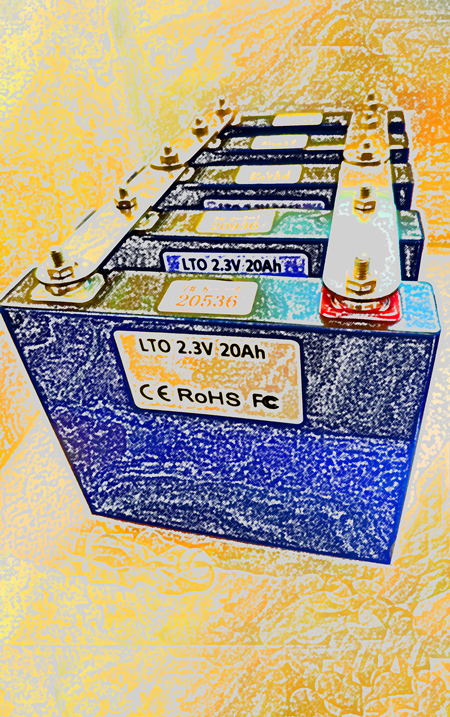 Lithium batteries have been the most popular battery for mobile and stationary energy storage now for many years, and have largely replaced lead-acid batteries as the battery of choice for stationary and mobile energy storage. The most sought-after lithium technology for RVers and home-based renewable energy enthusiasts alike is now lithium iron phosphate (LFP) batteries, but that may soon change with new technologies becoming cheaper and more available.
Lithium batteries have been the most popular battery for mobile and stationary energy storage now for many years, and have largely replaced lead-acid batteries as the battery of choice for stationary and mobile energy storage. The most sought-after lithium technology for RVers and home-based renewable energy enthusiasts alike is now lithium iron phosphate (LFP) batteries, but that may soon change with new technologies becoming cheaper and more available.
One of these technologies is lithium titanate oxide (Li2O3Ti), commonly known as LTO batteries. LTOs are by far the toughest, longest lasting batteries you can get and have been used for over 20 years in buses around the world, and more recently for car audio and electric car applications. They are extremely long-lived (over 40,000 cycles or 6 times more than Lithium Iron Phosphate / LiFePO4 / LFP, or 40 times longer than lead-acid or AGMs). Lithium titanate batteries operate at temperatures as low as -40℃ and are much safer than other chemistries (they can be punctured, burned, overcharged, and shorted out with no explosions or fires). This seems unbelievable, but it’s no joke: this is tried and tested tech.
Why haven’t you heard of these things? The only downsides to this technology in the past has been that they have been thought of as having a lower energy density per weight/size—which is actually misleading as they do in fact have higher usable energy density—more on this below, and they have traditionally cost significantly more than other battery types.
Luckily, their size has come down with the latest prismatic cell and pouch cell technology, and with increasing economies of scale (higher production) and more manufacturers entering the mix, prices are creeping into the range of other inferior lithium iron phosphate (LiFePO4 / LFP) and lead-acid batteries.
The same consideration means their price for the energy they provide is also better than it seems, since they have more usable energy. And since they last a heck of a lot longer than other batteries, their lifetime cost is much lower than any other battery technology. Although they may cost a bit more upfront, they will pay for themselves in a few years. Plus, you can add onto your LTO bank over time since they degrade so slowly, your next-of-kin will likely inherit them when you’re gone.
If you poke around the internet, you’ll find plenty of people saying they aren’t great for energy storage, and plenty of people who say they are. Opponents claim they have too low of energy density, but this doesn’t take into account the fact that they can be fully discharged and fully charged with little impact on their longevity, unlike lead-acid and LFP batteries. When lead-acid batteries fully discharge it significantly cuts into their already short lives, while with LFPs, which are often rated between 2,000 to 6,000 cycles at 80% discharge, you’ll also decrease their lifespan if you discharge them below 20% capacity left. They also don’t like being fully charged.
Lithium titanate shrugs off full discharge and full charge with only tiny reductions in lifespan compared to other lithium chemistries, meaning they actually have a much higher usable energy, thereby bringing their usable energy density above other chemistries.
Until now, however, no one has made these cells into consumer-level batteries. We’ll go into this a bit more below, but first let’s take a look at some of the advantages of LTOs.
- High stability and extreme longevity (20,000 to 40,000+ cycles!).
- Extremely safe: no thermal runaway or overheating, no lead (more environmentally safe).
- Low and high temperature charging, discharging, and storage (-50℃ – +60℃).
- Much faster charging potential compared to other lithium-ion batteries.
- No maintenance (e.g. no refills), no off-gassing, no temperature worries.
- Recharge efficiency exceeding 98% compared to e.g. 80% for AGMs.
- Extensive usability: can be used in solar and other energy storage power, solar hybrid street lighting, etc. Drop-in capabilities with most equipment such as Magnum inverters and Outback charge controllers. We’ll help you set your equipment to the right parameters.
- Prismatic cell construction in our batteries is more energy dense than other cylindrical cell lithium titanate batteries and thus more compact.
- Easy access to inside components if needed years down the road.
- High quality Heltec active cell-balancing technology to ensure cells remain balanced inside batteries to increase battery life.
- Locally manufactured in Ontario (with overseas components, for now!)
Note: If you research this battery chemistry further you will find a popular video of Will Prowse saying that he doesn’t recommend the batteries because they are not efficient and are more expensive than LFPs. However, he did his tests on Grade B cells, and admits this later in the comments and in a subsequent video after testing Grade A cells.
Some general information on lithium titanate oxide / LTOs / Li2O3Ti battery chemistry:
Nominal voltage: 2.4v per cell (most manufacturers)
Operating voltage:
Charge cut-off voltage: 2.7v per cell, or 16.2v for 6 series 12v systems, 32.4v for 12 series 24v systems, or 64.8v for 24 series 48V systems
Discharge cut-off voltage: 17.v per cell, or 10.2v (12v), 20.4 (24v), 40.8v (48v)
Standard Cycle life: ≥40,000+ cycles (@ 80% DOD, with 80% original capacity still after)
Operating temperature: between -30℃ and -50℃ to +60℃ depending on manufacturer and their tested specifications.
Rapid charging
Many LTO cells can be charged from 0% to over 80% SOC in one to five minutes.
Low-temperature operation
LTO cells can be charged and discharged at temperatures below the freezing point. There is virtually no degradation even if charge and discharge operation is repeated under very low temperature conditions, making it suitable for use in a wide range of temperatures.
How to Buy LTOs in Canada and the United States
Now that we’ve gone over the many benefits of LTOs and why we’re excited about them and have installed our own bank of LTOs on our off-grid farm, check out our options for LTOs in the U.S. and Canada on our Lithium Titanate Battery page. We’ve been working on making them available and are currently in the process of adding more options and becoming distributors for more LTO batteriies because we really believe in their quality, longevity, and environmental benefits.



